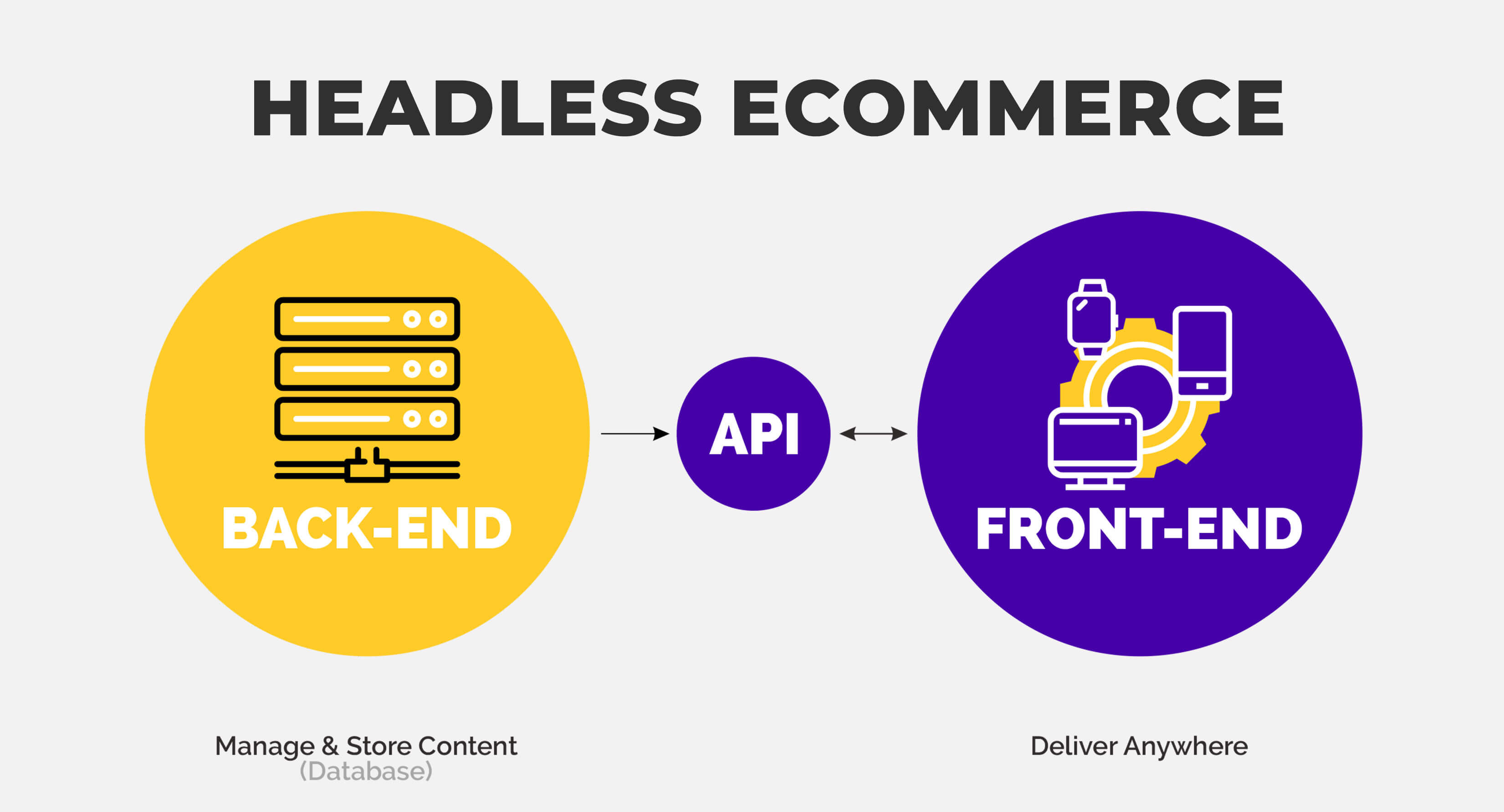
Headless eCommerce: Create Unique User Experiences with Your Ecommerce Platform
Headless commerce is now an emerging eCommerce trend that is sometimes referred to as the progression of online commerce in recent years. Many online businesses want to adopt a headless eCommerce platform because it is the essential step that will help them capitalize on this trend the most.
The architecture known as “headless commerce” is one in which the front-end layers are separated from the eCommerce back-end functions. The headless method allows you to design a distinctive and customized consumer experience on the front end by allowing two different layers to operate independently and interact via APIs. To make the eCommerce platform “headless,” the headless commerce approach will split the storefront layer from the platform itself. The eCommerce back-end functionality is still there and working in the meantime.
This article will examine the top headless eCommerce systems that may provide your company with limitless scalability and flexibility, as well as how these headless platforms can enable you to take advantage of headless commerce.
Headless eCommerce vs. Traditional eCommerce
Traditional eCommerce.
Because everything is packaged together, traditional commerce is cheap, simple to start up, and efficient to operate. These platforms provide many features combined into one interdependent system consisting of the content management system (CMS), shopping cart, web store design, and product management. They operate on a monolithic architecture with the front and back ends tethered together in a traditional “full stack” approach. These platforms give your IT teams complete platform control and are consistently effective. Setting up and maintaining a straightforward storefront is simple if you do not need regular updates.
Headless eCommerce.
Headless eCommerce is the distinction of all the combinations required to enable eCommerce on the web, not only the back-end and the front-end. Thanks to headless commerce, different systems may communicate through APIs and work together via interfaces to share information. Additionally, it isolates the processes from the data. It connects the information via APIs, enables machine communication, and facilitates data exchange between machines. Headless commerce entirely hides the complexity from the front-end since this communication between devices or systems occurs between the layers.
The system architecture of headless commerce makes sense. It is challenging and time-consuming to update all the components concurrently in a closely connected architecture. In contrast, it is simpler and more practical to update all the microservices in a decoupled environment owing to the design and logic. Headless commerce allows you to quickly and effectively expand your eCommerce operation, adjust to market trends, and introduce new CX initiatives.
Headless eCommerce Benefits
Flexibility and familiarity for developers.
With headless commerce, companies may use the front-end of their choosing, whether a CMS, a DXP, a PWA, or a bespoke solution, while still using the eCommerce platform that works best as the engine for their online shop.
The BigCommerce control panel enables retailers to locate and manage headless storefronts, cutting down on the technical list and sparing development resources. With the help of the Channels Toolkit, BigCommerce has made it simpler for developers to build unique headless solutions (as well as for merchants to find and use them). Here, you can read more about how it works.
If a development team is familiar with a specific technology or programming language, headless enables them to maintain their current workflow while reducing their procedures and creating efficiency.
Scalability.
Headless solutions may future-proof your brand by enabling you to modify your front-end without reorganizing the back-end as trends develop, and your business adjusts. Using frameworks and adding back-office functionality to your current system by front-end developers is made possible through APIs.
With a headless solution, you can handle each new capability separately and include new features as your site expands without starting from scratch with a brand-new website.
New technologies.
Brands can test new tech in a headless setting. Developers are free to construct any way they wish without being constrained by the constraints of a conventional CMS because of the decoupling of the front-end and the back-end.
The theme or template that determines what consumers see is often found in the front-end or “head” of eCommerce websites. Because you may connect a CMS, DXP, or Internet of Things (IoT) device that is expressly intended to enable content- or experience-led commerce, headless offers greater flexibility in content delivery. The front-end may then be changed without impacting back-end processes.
Create fast websites.
A quick website load time is essential when it comes to online purchasing. A whopping 70% of customers claim that page speed influences their choice to purchase from an online merchant, and Google research found that the likelihood of a bounce climbs sharply for every couple of seconds the page takes to load.
In addition, page load time affects search engine rankings for desktop and mobile queries, so the slower your site loads, the lesser your chances of appearing high in search results.
Fortunately, a headless eCommerce platform can centrally store content and send it to any location via APIs. Compared to conventional eCommerce systems, this strategy enables substantially quicker delivery, benefiting great client experiences.
Complete ownership over site architecture.
The content management and delivery application environments are separated on a headless commerce platform for better control.
Having a front-end solution, they are comfortable with and needing more from their back-end system is one reason businesses turn headless.
Brands may add or update what doesn’t work while keeping what does.
For instance, BigCommerce integrates with WordPress, Bloomreach, and Deity and enables merchants to provide API-driven experiences via any CMS, DXP, application, device, or custom front-end while BigCommerce runs the commerce engine.
Marketing effectiveness.
When creating new experiences on the front-end for a conventional monolithic system, your choices may be constrained.
As new eCommerce marketing trends emerge, you may incorporate new technology and change your approach with a headless solution. Your marketing team will therefore have complete freedom to innovate and create numerous user experiences across various channels, all without negatively affecting your back-end procedures.
With BigCommerce, retailers can access various third-party applications and native marketing tools. When you set up a BigCommerce shop, you’ll discover a variety of marketing options, including the following:
- Built-in blog.
- Social media sharing.
- Email marketing.
- Customer loyalty programs.
Customer Groups.
- Abandoned shopping cart saver.
Speed to market for international and omnichannel GTMs.
Apply the benefits listed above in combination with launching microbrands or new products in new markets.
A headless solution is quickly replicable across the board, optimized for global search engine optimization, and linked to the broader data orchestration infrastructure once the system is set up.
Developers may work on customer-facing experiences independently of the commerce engine since the front-end and back-end are separated. As a result, both the front-end and back-end teams may innovate without waiting for one another to complete.
Because of this, SaaS and headless commerce may aid eCommerce firms in reaching their target markets more quicker. BigCommerce even offers corporate launch packages and data transfer services to help retailers integrate their current systems and reach their target audiences more quickly.
Improve conversion rates and lower customer acquisition costs.
Due to increased paid advertising, customer acquisition expenses are growing for many firms.
Because your firm may utilize a content- or experience-led approach to attract organic visitors rather than depending on paid advertising, headless is an excellent method to save these expenditures.
Try several front-end and back-end approaches simultaneously to determine which option generates the most traffic. By performing ongoing testing and experimenting with different templates, you can better understand your customers and increase your conversion rate than typical internet firms.
Go truly omnichannel.
A single-channel strategy is no longer enough, given that 73% of consumers utilize several channels when making a transaction, and 76% prefer alternative media depending on the circumstance.
Fortunately, losing your head allows you to advertise your content on all your current channels and any future ones you add. You can add various online and offline experiences because you can change your front-end without changing your back-end, whether a mobile app, an online marketplace, or an IoT device like a smartwatch or mirror. Your commerce engine is continuously operating in the background.
Making items available outside your online shop via headless platforms allows retailers to develop omnichannel experiences. For BigCommerce merchants, these sales channels are accessible regardless of your plan. BigCommerce Channel Manager makes it simple to sell on:
- Pinterest.
- Anywhere you can add HTML with buy buttons.
- eBay.
- Amazon.
Headless eCommerce Use Cases
1. Improving the digital experience on existing web applications and mobile apps
Numerous businesses run legacy web applications or mobile apps that support different stages of the customer experience. Financial services are one instance of this. Customers may access the online personal banking applications that most banks have established using mobile apps or desktop browsers.
Instead of spending millions of dollars on replacing these legacy systems with commercial CMS or eCommerce applications, businesses are opting to implement a headless CMS that can show users banners, articles, and promotional offers. This capability is crucial for many financial institutions looking to increase account stickiness with cross-selling and up-sell offers. At the same time, they are engaged in personal banking.
2. Reaching customers on emerging touchpoints
Over 83 million homes in 2019 had at least one smart device, and the number of smart home gadgets is growing. To provide users with experiences, these intelligent gadgets often leverage built-in services like Google Home or Alexa. Organizations want a CMS or eCommerce platform that can send content to or process orders from various channels as these platforms grow in use and maturity. Both may be done using a headless CMS or e-commerce application. A headless platform will be able to interface with the underpinnings of the experience-delivery architecture used by smart devices (such as Google Home and Alexa). This may be as easy as letting customers make voice orders with your business from the gadget or as complex as running an Alexa Skill directly on an Amazon Echo.
3. Ground-up builds for digitally native startups
Almost all industries are being transformed by digital. Digitally driven firms, including 23andMe, Casper, and Uber, are upending the existing quo while gaining market dominance. As you could have suspected, they’re doing it with headless. Technology executives have firsthand experience with the experience silos that monolithic systems create, which are costly to operate and deter consumer participation. This is why digitally native startups use headless microservice applications that connect to a single company-built presentation layer to create consumer apps.
In theory, this cross-functional front-end code makes firms quicker at completing their missions and more adaptable to changing consumer expectations. It also promotes consistency in the user experience. This is a wise course of action for a startup with ample resources, lofty goals, and rock-star technical talent. However, most businesses today that purchase e-commerce and digital experience solutions are not in this situation, rendering the argument for a cross-functional presentation layer irrelevant. As front-end code becomes obese and developer resources are spread thin throughout an expanding firm, the presentation layer will eventually impede innovation. Technology experts should carefully examine pure-headless architectures to avoid writing front-end code replicating the monolithic nightmare.
The Good and the Beautiful
The growing disparity between front-end and back-end technology has increased the number of stores using the headless commerce strategy. A headless commerce solution is a collection of back-end services that can be accessed by any front-end solution, eliminating the outdated practice of bundling a commerce solution with a fully integrated storefront. As a result, businesses may reinvent their storefront user interface (UI) without being constrained by the back-end system and apps.
Organizations may respond to market changes more quickly and shorten the time it takes to provide new features and updates to their products by separating the development cycles for the commerce engine and storefront. This is essential in a dynamic economy.
FAQs About Headless Ecommerce
Is headless CMS the same as Headless eCommerce?
Businesses with an eye on the future may now customize user experiences more, thanks to headless architecture. B2B companies can now adapt to changing client expectations in the future thanks to headless, API-first e-commerce platforms that enable unique ordering experiences for your customers and headless CMSs that power custom content models for contemporary, powerful user experiences.
How is iExperto headless different from Adobe Commerce (Magento) headless?
iExperto serves mobile-friendly single-page applications (SPAs) and progressive web apps using blazing-fast front-end frameworks like React.js and its relatives (PWAs). You may easily add new technologies and gadgets to what you’ve established on your back end when they become available.
Does every eCommerce store need a headless solution?
No, not all online shops need a headless solution. Many agencies still advocate a monolithic approach for large businesses and well-known brands. The monolithic model, which has been a mainstay of eCommerce for years, is still used by several firms.
Do I need a developer for Headless eCommerce?
The best teams to use a headless CMS are seasoned developers (or trusted agencies or third-party developers) with the expertise to create and maintain the front-end frameworks that the headless CMS will power. Additionally, the organization must desire to deploy distinctive experiences across touchpoints and the need for agility.
Is Headless eCommerce the future of eCommerce?
The client experience is significantly impacted by headless eCommerce. Businesses may swiftly embrace new technology touchpoints, influence the purchase process, and increase customer engagement through personalized, creative digital experiences. There is also a great deal of room for testing and experimenting.

